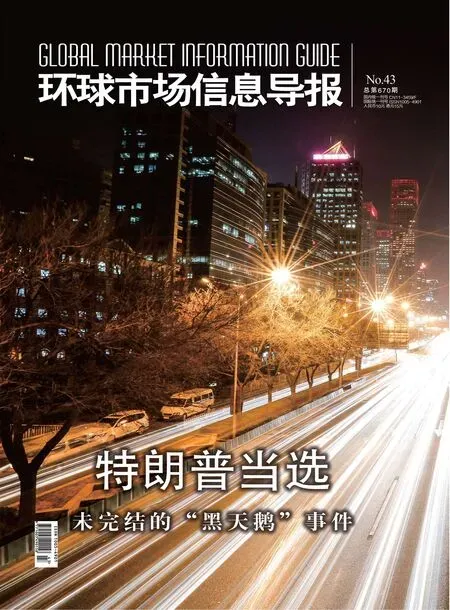Trump elected: An unfinished Black Swan Event
2017-01-10
Trump elected: An unfinished Black Swan Event

The term black swan is well known after the 2008 Financial Crisis, and it means the occurrence of very impossible event and its consequential impacts.
At the US local time on the ninth November, Donald Trump who was the presidential candidate of the Republican Party defeated his opponent—Hillary Clinton, the candidate of the Democratic Party, and won the 2016 US president election. According to analysts, this was a US—style Black Swan event whose impact was far more than the Brexit referendum.
On November 21, Trump presented a game-changing plan for his first 100 days in office including TPP quit, entirely ignoring the sitting president Obama who still energetically advocated TPP at 2016 APEC Summit in Peru.
Will the US quit TPP really? Will the Trump-style TPP roll out? What impact of the Trump’s economic policy will be exerted on Sino-US trade and even on the world economy? Maybe, these will become a series of the black swan events after his election.
Trump elected: American Dream in the power game
A scene similar to Brexit referendum occurred in 2016 US presidential election: most of pre-election polls failed in election predication. For this, a US media commented: “Every one are wrong”. For Hillary, it was counteroffensive to the politicians that Trump was elected who had no political experience, and also became another version of the US Dream.
Presidents’ struggle: What the TPP to follow?
Till now, TPP is still a scrap of paper. It is said that only a few could completely read more than 5000 pages of the agreement. About TPP, there is a heated struggle between the sitting president Obama and the president-elected Trump.
America first: How to impact the world economy?
The New York Times said Trump was the elected president who didn’t best prepare to be of the modern times”. The world will wait and see whether Trump will practice the policies asserted in his political campaign in office. It is similarly concerned what impact his America First will exert on the Sino-US economic trade relations and even the world economy.

The synergetic development of the Beijing-Tianjin-Hebei Region is one of the three-region strategies carried currently in China. It is clearly set forth in the 13th Five-Year Plan of Beijing CBD Functional Zone that the Beijing CBD will be built as a “sharing CBD” in the region by constructing the multi-level CBD network with the global influence. By this way, the region is guided into the world-level city agglomeration, so that it can participate in the international competitions and cooperation at a higher level.
Building a sharing CBD is an objective requirement for promoting the synergetic development of Beijing-Tianjin-Hebei Region and building a world-level urban agglomeration
The formation and development of metropolis economic circle and urban agglomeration are the important features of modern cities, and also one of the trends for development of global and regional economic integration. With industrial divisions and cooperation worldwide, different forms of regional integration or regional economic community are coming into being, and the world competition has been in regional conglomeration sage. The metropolis economic circles and the urban agglomeration mainly consisting of these economic circles have become the main carriers for one country to participate in the international competition. For this reason, the National New Urbanization Plan (2014—2020) gave clear requirements: the Beijing-Tianjin-Hebei Region, the Yangtze River Delta and the Pear River Delta will be built the world-level urban agglomerations as an objective, so as to speed up their new advantages in the international competition, participate in international cooperation and competition at a higher level, and give play to the important support and guiding to China’s economical and social development.
According to international experiences, the CBD, as an important growth pole, played an important role in attracting headquarters economy, gathering international resources, boosting elements flow and forming an international influence of urban agglomeration in the development of the world-level urban agglomeration or metropolis economic circles. In the development of such worldlevel urban agglomerations as New York, Tokyo, Paris and London metropolis circles, their CBDs substantially played a core role, and they presented powerful economic and cultural magnetic forces and driving ability. Their central cities were organized and agglomerated in economic development based on the CBD, and the entire metropolis economic circle and urban agglomeration were developed by industrial expansion, population mobility, and cash flow, as well as merger and acquisition, cooperation consortium.
From the developing stages, currently Beijing has ushered in an agglomeration-radiation stage from the agglomeration stage, and a pure “siphonic effect” to an “irradiation effect”. A synergetic development trend is coming into being step by step for the Beijing-Tianjin-cored capital economy circle and its agglomeration. In the future, the important thing is to make clear the CBD’s functions and positioning in the Beijing-Tianjin-Hebei Region to build the sharing CBD services, guide the Beijing-Tianjin-Hebei synergetic development, and drive the Beijing-Tianjin-Hebei world-level agglomeration.
Building an Beijing-Tianjin-Hebei regional sharing CBD with platform joint development, service sharing, industrial linkage and synergetic development
The key tasks for the Beijing CBD’s construction and development during the 13th Five-Year Plan are: Build the multi-level CBD network with the global influence based on international experiences, so as to promote platform joint development, service sharing, network intercommunication, industrial linkage and synergetic development; build Beijing CBD into a “sharing CBD” shared in the entire Beijing-Tianjin-Hebei region to serve the synergetic development of the region, and boost Beijing, Tianjin and Hebei region to become a world-level urban agglomeration.
